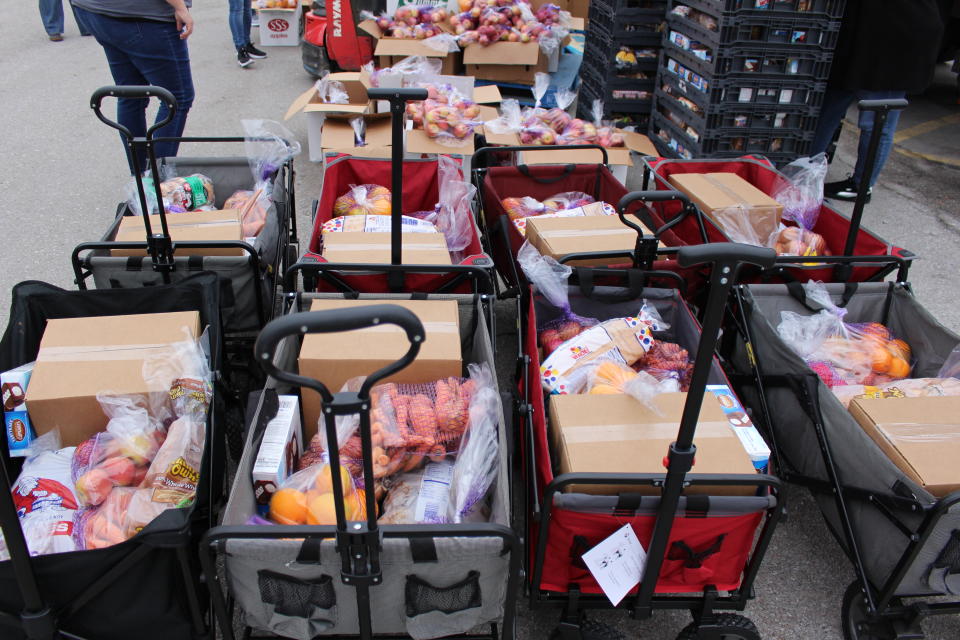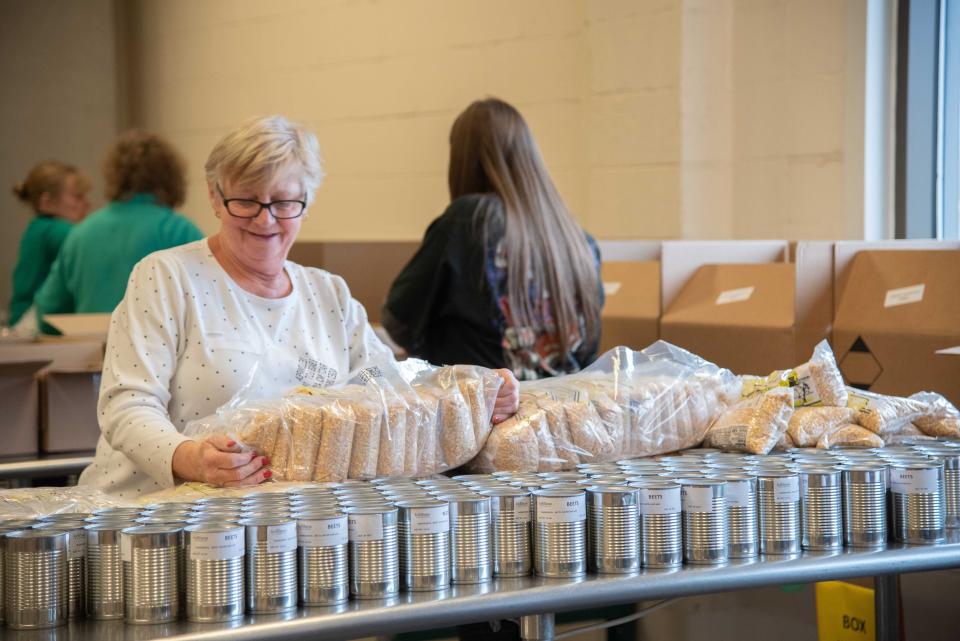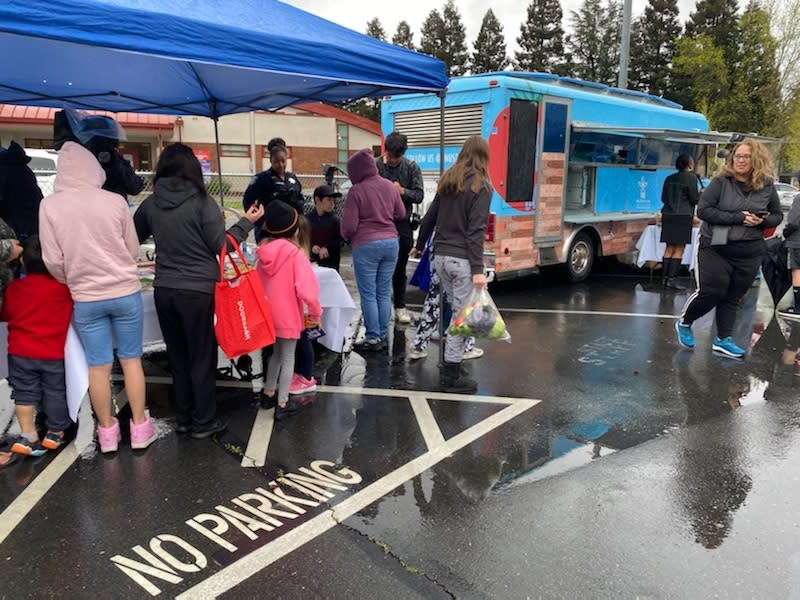Food nonprofits concerned about food supply and coronavirus: 'Our programs are struggling'
With schools closed in 46 states across America and early reports of widespread layoffs, record-breaking demand for food donations in the U.S. has put a strain on nonprofits nation-wide.
Nonprofit leaders say they are concerned about food supply shortages in the coming weeks and are struggling to quickly build new infrastructure that enforces social distancing — while attempting to feed large numbers of people during the COVID-19 pandemic.
“What we’re hearing from vendors is a little scary, honestly,” says Clint McKnight, Director of Domestic Programming for Feed the Children. Last year the organization distributed 68.6 million pounds of food and essentials to 4.7 million people in the U.S., and currently provides summer meals for students who depend on free breakfast and lunch at school. “They’re talking about manufacturing times and lead times, and the stuff they’ve already ramped up for summer, like those free summer meals that we would normally buy or purchase now — we had a vendor say it’s almost 14 weeks out to get that. That’s concerning to us.”
It’s concerning because McKnight says he needs those meals now. “The need we would normally see in the summertime is now hitting exactly here in the middle of March.” And, he says the need is growing. “It’s not just the kids that rely on the school meal, it’s that no one can get out and get access to the food they need, the shelves are empty.”
McKnight says they are starting to see some shortages in fresh fruits and vegetables and shelf-stable meal kits. Instead, they’re handing out more canned goods. “I don't think there’s going to be a nation-wide shortage of all foods, but I think we’re going to see shortages. We already are starting to see some.”
No Kid Hungry, a nonprofit campaign that funds several large food banks that in turn supports hundreds of soup kitchens and pantries, estimates there are 22 million kids in need daily who rely on free school lunches, and 13 million kids who rely daily on free school breakfast. The organization estimates that over 168 million meals at school have been missed by kids in need due to school closures since the pandemic hit the United States earlier this month.
Spokespeople from both US Foods and Sysco, two of the largest players in the food-service distribution industry, both say the companies are committed to working closely with nonprofits like Feeding America.
When asked about the company’s capacity to assist food nonprofits during the coronavirus pandemic, US Foods tells Yahoo Lifestyle in a written statement that they “expect to see these donations to continue as this situation unfolds.”
Last week, Sysco, one of the nation’s largest food distribution companies, pledged 2.5 million meals over the next four weeks as part of its response strategy to the COVID-19 pandemic. A company spokesperson says Sysco plans to work closely with organizations like Feeding America.
Feeding America tells Yahoo Lifestyle that inventory is delayed or declining due to the outbreak. The nonprofit supplies food to the nation's largest network of food banks and reaches over 40 million people in need and depends heavily on donations from grocery stores. This comes at a time when the organization is seeing food demand increase fourfold across the nation due to coronavirus shelter-in-place orders.
A spokesperson for Feeding America says retail food donations from major grocery stores, which make up 35 percent of the organization's food supply to American food banks, have slowed. “They’re delayed or they’re declining right now because there’s less inventory in the stores, less for them to donate... due to stockpiling,” the spokesperson said.

“Our programs are struggling with basic supplies like hand sanitizers, gloves, things like that because they’re in such high demand,” says Jenny Young, Vice President of Communications for Meals on Wheels America which provides daily meals to isolated senior citizens across the country. Now, with orders to shelter-in-place, Young says the number of seniors in need of meals has increased dramatically, seeing a 650 percent spike in online traffic for those seeking information on receiving meals.
There has also been a surge in those online looking to volunteer nationally. But Young says cash donations are much more urgent than volunteers. “We have 2 million volunteers across the country and that’s what makes Meals on Wheels work, and it’s just interesting right now we don’t want to put anyone in a situation where we are making matters worse because we have volunteers out and about.”
Distribution of meals for these nonprofits has dramatically changed in the span of a week. In order to reduce contact with the elderly, some Meals on Wheels volunteers are delivering a week’s worth of food at one time, or leaving meals on the door and making a phone call from afar to ensure the meals were received.
For nonprofits that feed kids during school, the massive school shut-downs and social distancing rules have completely disrupted food distribution networks that have been operating for decades, and are forcing organizations to innovate in real-time.
“Now all that disappears overnight, completely gone and you’ve got to create this alternate universe of feeding kids from grab-and-go sites and drive-by tents at schools, said Billy Shore, Founder and Executive Chair of Share Our Strength, the organization that runs the No Kid Hungry campaign. “We need different kinds of equipment, different resources.”
No Kid Hungry, released its first emergency $1 million grant on Friday to school districts, food banks and local organizations feeding kids nation-wide.
Shore says the money is going towards new forms of distribution, including a food truck in a California school district that delivers warm, free food to kids while schools are closed. In Augusta, Georgia, bus drivers are delivering meals along their normal routes and dropping off meals where they used to pick up kids.
He says No Kids Hungry plans to release an additional $4 million in emergency grants in the coming weeks. Shore says donations to the organization have skyrocketed in the last few days from an average of 500 per month to over 17,000 donations since March 1 (he says they are still in need of more).
But Shore’s real concern is how vulnerable children in need are handling the pandemic. He points to a worker who tested positive in the Memphis school system earlier this week, which resulted in the entire food program in the community being shut down.
“It then becomes a question of, is there some other way to get food to kids without using food workers? It gets pretty difficult,” he said.
A spokesperson for Feeding America, which distributes provisions to over 200 food banks around the country, says many food banks are creating drive through pickups, where food is placed directly into cars, grab-and-go pantries, and are scheduling pickup times to limit the number of people congregating on-site at one time. The organization has established the COVID-19 Response Fund and is seeking donations to give communities the flexibility to react to the unique needs in their area, from buying additional cleaning supplies, food or hiring temp workers in the absence of new volunteers.

Here’s where you can donate:
Feed the Children aims to end childhood hunger around the world. Donate here.
Feeding America: This organization works with manufacturers, distributors, retailers, food service companies and farmers to distribute food to those in need… food that would otherwise go to waste. Donate here or find a local food bank here.
No Kid Hungry: The campaign claims there are more than 169 million meals to date that children have missed in America due to school closures from coronavirus. Right now, Citi is matching all donations up to $2M. Recent donations enabled No Kid Hungry to release its first round of $1 million dollar grant funding to school districts, food banks and local organizations feeding kids nationwide. Donate here.
Meals on Wheels: goal is to support senior neighbors. Currently helping 2.4 million seniors every year in every community in the country. Donate here.
For the latest news on the evolving coronavirus outbreak, follow along here. According to experts, people over 60 and those who are immunocompromised continue to be the most at risk. If you have questions, please reference the CDC and WHO’s resource guides.



